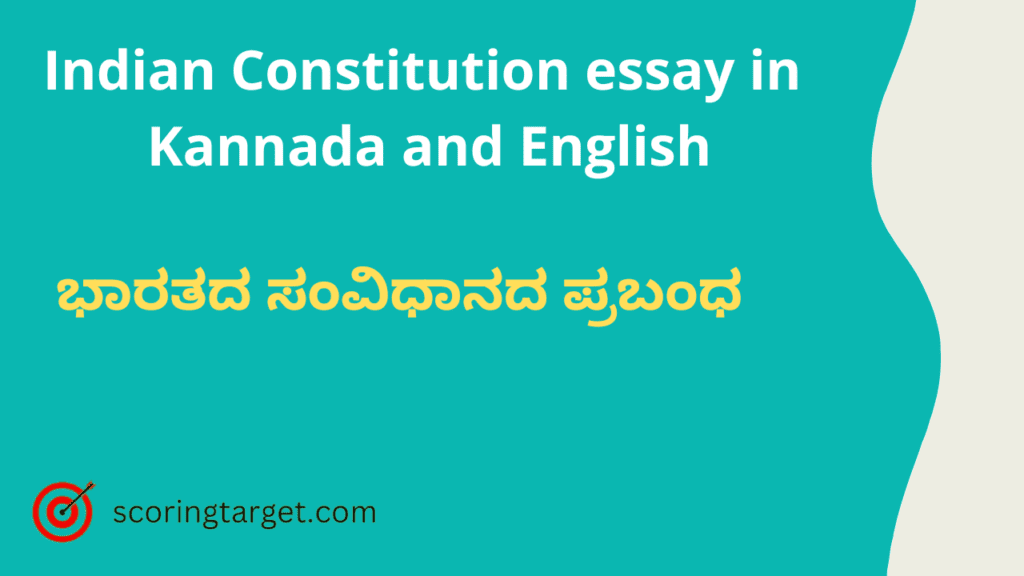Indian Constitution essay in Kannada and English. Short essay on Indian Constitution in Kannada and English. Short essay for high school students.
In this video we are going to explain Indian Constitution essay for competitive exam. Write a short essay on Indian Constitution in Kannada. We have also given Indian Constitution essay in English.
To get more video notes for essay writing, visit our YouTube channel. This channel is very useful for Kannada and English.

Indian Constitution essay in Kannada:
ಪೀಠಿಕೆ:
ಸಂವಿಧಾನವು ಒಂದು ದೇಶದ ಆಡಳಿತಕ್ಕೆ ಮಾರ್ಗದರ್ಶನ ನೀಡುವ ನಿಯಮಗಳು ಮತ್ತು ನಿಬಂಧನೆಗಳ ಒಂದು ಗುಂಪಾಗಿದೆ. ಸಂವಿಧಾನವು ರಾಷ್ಟ್ರದ ಪ್ರತಿಯೊಂದು ಪ್ರಜಾಸತ್ತಾತ್ಮಕ ಮತ್ತು ಜಾತ್ಯತೀತ ರಚನೆಯ ಬೆನ್ನೆಲುಬು. ಭಾರತದ ಸಂವಿಧಾನವು ವಿಶ್ವದ ಅತ್ಯಂತ ಉದ್ದವಾದ ಸಂವಿಧಾನವಾಗಿದೆ. ಇದು ರಾಜಕೀಯ ತತ್ವಗಳು, ಕಾರ್ಯವಿಧಾನಗಳು ಮತ್ತು ಸರ್ಕಾರದ ಅಧಿಕಾರಗಳ ಚೌಕಟ್ಟನ್ನು ವಿವರಿಸುತ್ತದೆ. ಭಾರತದ ಸಂವಿಧಾನವನ್ನು 26 ನವೆಂಬರ್ 1949 ರಂದು ಬರೆಯಲಾಯಿತು ಮತ್ತು 26 ಜನವರಿ 1950 ರಂದು ಜಾರಿಗೆ ಬಂದಿತು.
ಭಾರತದ ಸಂವಿಧಾನವನ್ನು ಹೇಗೆ ರಚಿಸಲಾಯಿತು?
1946 ರಲ್ಲಿ ರಚನೆಯಾದ ಸಂವಿಧಾನ ಸಭೆಯಿಂದ ಭಾರತೀಯ ಸಂವಿಧಾನವನ್ನು ರಚಿಸಲಾಯಿತು. ಡಾ ರಾಜೇಂದ್ರ ಪ್ರಸಾದ್ ಅವರನ್ನು ಸಂವಿಧಾನ ಸಭೆಯ ಅಧ್ಯಕ್ಷರಾಗಿ ಆಯ್ಕೆ ಮಾಡಲಾಯಿತು. ಸಂವಿಧಾನವನ್ನು ವಿನ್ಯಾಸಗೊಳಿಸಲು ಕರಡು ಸಮಿತಿಯನ್ನು ರಚಿಸಲಾಯಿತು, ಡಾ ಬಿಆರ್ ಅಂಬೇಡ್ಕರ್ ಅಧ್ಯಕ್ಷರಾಗಿ ಸೇವೆ ಸಲ್ಲಿಸಿದರು. ಸಂವಿಧಾನದ ರಚನೆಯು ಎರಡು ವರ್ಷ, ಹನ್ನೊಂದು ತಿಂಗಳು ಮತ್ತು ಹದಿನೆಂಟು ದಿನಗಳನ್ನು ತೆಗೆದುಕೊಂಡಿತು.
ಭಾರತದ ಸಂವಿಧಾನದ ಗುಣಲಕ್ಷಣಗಳು:
ಭಾರತೀಯ ಸಂವಿಧಾನವು ಸಂವಿಧಾನದ ಮೂಲಭೂತ ಗುರಿಗಳು ಮತ್ತು ಮೌಲ್ಯಗಳನ್ನು ಒಳಗೊಂಡಿರುವ ಮುನ್ನುಡಿಯೊಂದಿಗೆ ತೆರೆಯುತ್ತದೆ. ಇದು ಸಂವಿಧಾನದ ಗುರಿಗಳನ್ನು ಸ್ಥಾಪಿಸುತ್ತದೆ.
1. ವಿಶ್ವದ ಅತಿ ಉದ್ದದ ಸಂವಿಧಾನ:
ಭಾರತದ ಸಂವಿಧಾನವು ವಿಶ್ವದ ಅತಿ ಉದ್ದದ ಸಂವಿಧಾನವಾಗಿದೆ. ಇದನ್ನು ಪ್ರಾರಂಭಿಸಿದಾಗ, ಇದು 22 ವಿಭಾಗಗಳು ಮತ್ತು ಎಂಟು ವೇಳಾಪಟ್ಟಿಗಳಲ್ಲಿ 395 ವಿಷಯಗಳನ್ನು ಒಳಗೊಂಡಿತ್ತು. ಭಾರತೀಯ ಸಂವಿಧಾನಕ್ಕೆ 104 ತಿದ್ದುಪಡಿಗಳನ್ನು ಮಾಡಲಾಗಿದೆ.
2. ಭಾರತೀಯ ಸಂವಿಧಾನದ ಬಿಗಿತ ಮತ್ತು ನಮ್ಯತೆ:
ನಮ್ಮ ಸಂವಿಧಾನದ ವಿಶಿಷ್ಟ ಲಕ್ಷಣವೆಂದರೆ ಅದು ಅಮೆರಿಕನ್ ಸಂವಿಧಾನದಷ್ಟು ಕಠಿಣವಾಗಿಲ್ಲ. ಇದು ಗಟ್ಟಿಯಾದ ಮತ್ತು ಹೊಂದಿಕೊಳ್ಳುವ ಎರಡನ್ನೂ ಸೂಚಿಸುತ್ತದೆ. ಪರಿಣಾಮವಾಗಿ, ಕಾಲಾನಂತರದಲ್ಲಿ ಅದು ಸುಲಭವಾಗಿ ಬದಲಾಗಬಹುದು ಮತ್ತು ವಿಸ್ತರಿಸಬಹುದು.
3. ಏಕೀಕೃತ ಗುಣಲಕ್ಷಣಗಳೊಂದಿಗೆ ಫೆಡರಲ್ ವ್ಯವಸ್ಥೆ:
ಸರ್ಕಾರದ ಅಧಿಕಾರಗಳನ್ನು ಕೇಂದ್ರ ಸರ್ಕಾರ ಮತ್ತು ರಾಜ್ಯ ಸರ್ಕಾರಗಳ ನಡುವೆ ಹಂಚಲಾಗುತ್ತದೆ. ಕಾರ್ಯಾಂಗ, ನ್ಯಾಯಾಂಗ ಮತ್ತು ಶಾಸಕಾಂಗ ಎಂಬ ಮೂರು ಸರ್ಕಾರಿ ಸಂಸ್ಥೆಗಳ ಅಧಿಕಾರಗಳನ್ನು ಸಂವಿಧಾನದ ಅಡಿಯಲ್ಲಿ ವಿಂಗಡಿಸಲಾಗಿದೆ. ಪರಿಣಾಮವಾಗಿ, ಭಾರತೀಯ ಸಂವಿಧಾನವು ಫೆಡರಲ್ ರಚನೆಯನ್ನು ಪ್ರತಿಪಾದಿಸುತ್ತದೆ.
4. ಮೂಲಭೂತ ಹಕ್ಕುಗಳು ಮತ್ತು ಮೂಲಭೂತ ಕರ್ತವ್ಯಗಳು:
ಭಾರತೀಯ ಸಂವಿಧಾನವು ಭಾರತೀಯ ನಾಗರಿಕರಿಗೆ ಮೂಲಭೂತ ಹಕ್ಕುಗಳ ಸಮಗ್ರ ಗುಂಪನ್ನು ವಿವರಿಸುತ್ತದೆ. ಸಂವಿಧಾನವು ನಾಗರಿಕರಿಗೆ 11 ಜವಾಬ್ದಾರಿಗಳ ಪಟ್ಟಿಯನ್ನು ಒಳಗೊಂಡಿದೆ, ಇದನ್ನು ಮೂಲಭೂತ ಕರ್ತವ್ಯಗಳು ಎಂದು ಕರೆಯಲಾಗುತ್ತದೆ. ಈ ಕೆಲವು ಜವಾಬ್ದಾರಿಗಳಲ್ಲಿ ರಾಷ್ಟ್ರಧ್ವಜ ಮತ್ತು ಗೀತೆಗೆ ಗೌರವ, ದೇಶದ ಸಮಗ್ರತೆ ಮತ್ತು ಏಕತೆ ಮತ್ತು ಸಾರ್ವಜನಿಕ ಆಸ್ತಿಯ ರಕ್ಷಣೆ ಸೇರಿವೆ.
Write a short essay on Indian Constitution in Kannada
5. ರಾಜ್ಯ ನೀತಿಯ ನಿರ್ದೇಶನ ತತ್ವಗಳು:
ರಾಜ್ಯ ನೀತಿಯ ನಿರ್ದೇಶನ ತತ್ವಗಳು , ಸಂವಿಧಾನದ ಭಾಗ IV ರಲ್ಲಿ ಪ್ರತಿಪಾದಿಸಲಾಯಿತು, ಸಾಮಾಜಿಕ-ಆರ್ಥಿಕ ಅಭಿವೃದ್ಧಿ, ಕಲ್ಯಾಣ ಮತ್ತು ನ್ಯಾಯಯುತ ಸಮಾಜದ ಸ್ಥಾಪನೆಗಾಗಿ ರಾಜ್ಯಕ್ಕೆ ಮಾರ್ಗಸೂಚಿಗಳನ್ನು ನೀಡಲಾಗಿದೆ. ಈ ವಿಭಾಗವು ನಿರ್ದೇಶನ ತತ್ವಗಳ ಪ್ರಾಮುಖ್ಯತೆ ಮತ್ತು ವರ್ಗೀಕರಣವನ್ನು ಪರಿಶೀಲಿಸುತ್ತದೆ, ಸಾಮಾಜಿಕ ನ್ಯಾಯ, ಆರ್ಥಿಕ ಸಬಲೀಕರಣ ಮತ್ತು ಪರಿಸರ ಸಂರಕ್ಷಣೆಯಂತಹ ಕ್ಷೇತ್ರಗಳ ಮೇಲೆ ಕೇಂದ್ರೀಕರಿಸುತ್ತದೆ.
6. ತುರ್ತು ನಿಬಂಧನೆಗಳು:
ಬಿಕ್ಕಟ್ಟಿನ ಸಮಯದಲ್ಲಿ, ರಾಷ್ಟ್ರದ ಮತ್ತು ಭದ್ರತೆಯನ್ನು ಖಚಿತಪಡಿಸಿಕೊಳ್ಳಲು ಸ್ಥಿರ ತುರ್ತು ಪರಿಸ್ಥಿತಿಗಳ ಘೋಷಣೆಗೆ ಸಂವಿಧಾನವು ಸೂಕ್ತವಾಗಿದೆ. ಈ ವಿಭಾಗವು ವಿವಿಧ ರೀತಿಯ ತುರ್ತುಸ್ಥಿತಿಗಳನ್ನು ವಿವರಿಸುತ್ತದೆ – ರಾಷ್ಟ್ರೀಯ, ರಾಜ್ಯ ಮತ್ತು ಹಣಕಾಸು – ಮತ್ತು ಸರ್ಕಾರದ ಕಾರ್ಯನಿರ್ವಹಣೆ ಮತ್ತು ವೈಯಕ್ತಿಕ ಹಕ್ಕುಗಳ ಮೇಲೆ ಪರಿಣಾಮ ಬೀರುತ್ತದೆ.
ಉಪಸಂಹಾರ: ಸಂವಿಧಾನವು ತನ್ನ ನಾಗರಿಕರಿಗೆ ಮಾರ್ಗದರ್ಶಕ ಬೆಳಕಿನಂತೆ ಕಾರ್ಯನಿರ್ವಹಿಸುತ್ತದೆ. ಈ ಭಾರತೀಯ ಸಂವಿಧಾನದಲ್ಲಿ ಎಲ್ಲವನ್ನೂ ಚೆನ್ನಾಗಿ ವ್ಯಾಖ್ಯಾನಿಸಲಾಗಿದೆ. ಇದು ಭಾರತಕ್ಕೆ ಗಣರಾಜ್ಯ ಸ್ಥಾನಮಾನ ಪಡೆಯಲು ಸಹಾಯ ಮಾಡಿದೆ. ಡಾ. ಬಿ.ಆರ್. ಅಂಬೇಡ್ಕರ್ ಮತ್ತು ಭಾರತೀಯ ಸಂವಿಧಾನದ ಕರಡು ಸಮಿತಿಯ ಸದಸ್ಯರು ನಿಜವಾಗಿಯೂ ಶ್ಲಾಘನೀಯ ಕೆಲಸ ಮಾಡಿದ್ದಾರೆ ಅದಕ್ಕಾಗಿ ಅವರು ಯಾವಾಗಲೂ ಸ್ಮರಣೀಯರಾಗಿದ್ದಾರೆ.
Indian Constitution essay in English:
Introduction:
A constitution is a set of rules and regulations that guide the governance of a country. Constitution is the backbone of every democratic and secular structure of a nation. Indian constitution is the longest constitution in the world. It describes the political principles, procedures and framework of government powers. The Constitution of India was written on 26 November 1949 and came into force on 26 January 1950.
How was the Constitution of India framed?
The Constitution of India was framed by the Constituent Assembly formed in 1946. Dr Rajendra Prasad was elected as the President of the Constituent Assembly. A Drafting Committee was formed to design the Constitution, with Dr BR Ambedkar serving as Chairman. The drafting of the constitution took two years, eleven months and eighteen days.
Characteristics of Constitution of India:
The Constitution of India opens with a Preamble which contains the basic aims and values of the Constitution. It establishes the objectives of the Constitution.
Indian constitution speech in English
1. World’s Longest Constitution:
Indian constitution is the longest constitution in the world. Constitution contained 395 subjects in 22 sections and eight schedules.
2. Rigidity and Flexibility of Indian Constitution:
A distinctive feature of our constitution is that it is not as rigid as the American constitution. It refers to both rigid and flexible. As a result, it can easily change and expand over time.
3. Federal system with unitary characteristics:
The powers of the government are divided between the central government and the state governments. The powers of the three government bodies namely the executive, judiciary and legislature are divided under the constitution. Consequently, the Indian Constitution advocates a federal structure.
4. Fundamental Rights and Fundamental Duties:
The Indian Constitution outlines a comprehensive set of fundamental rights for Indian citizens. The Constitution contains a list of 11 responsibilities for citizens, known as Fundamental Duties. Some of these responsibilities include respect for the national flag and anthem, integrity and unity of the country and protection of public property.
Short essay on Indian Constitution in English
5. Guiding Principles of State Policy:
The Directive Principles of State Policy, enshrined in Part IV of the Constitution, provide guidelines to the State for socio-economic development, welfare and establishment of a just society. This section examines the importance and classification of guiding principles, focusing on areas such as social justice, economic empowerment and environmental protection.
6. Emergency Provisions:
In times of crisis, the Constitution is appropriate for the declaration of permanent states of emergency to ensure national and security. This section describes different types of emergencies – national, state and financial – and affects the functioning of government and individual rights.
Conclusion:
The Constitution acts as a guiding light for its citizens. It helped India get republic status. Dr. B.R. Ambedkar and the members of the Drafting Committee of the Constitution of India have done a truly commendable work for which they will always be remembered.
Watch this video for the explanation of Indian Constitution essay in Kannada and English.
Related posts:
5. Essay on National Voters Day
